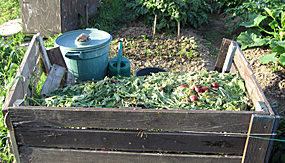
© Pirjo Ferin
In the CircVol project, a part of the 6Aika Strategy of the City of Helsinki, an assessment was completed to find out what kind of biological flows, such as industrial biowaste, is produced in the capital region. The project also seeks to achieve the goals of the roadmap of circular and sharing economy, published by the City of Helsinki this year.
The goal of the regional biomass assessment was to identify biomass and sharing circular economy flows that the businesses can use as raw materials in the production of bio-gas or landscaping. The Project Manager of the CircVol project with the City of Helsinki, Heli Lehtinen, got the idea from a Swedish project that is turning the material flows in the Malmö region into a digital map service.
“Originally, our goal was to create a single assessment test for the use of the Norrberget industrial area”, Lehtinen explains. The industrial area’s completion was delayed, but defining the assessment locally made it more efficient. “Finding information becomes more difficult as soon as regional borders are crossed.”
The background information regarding the production and processing facilities of biomass is based on the Biomass Atlas of the Natural Resources Institute Finland and the YLVA database. More in-depth data was sought at a local level. “We received more information of environmental permits from environmental inspectors of nearby municipalities", says Project Assistant of the City of Helsinki, Jenna Inkinen. Help for the collection and analysis of waste data of smaller companies is available from the statistical experts of the Helsinki Region Environmental Services Authority (HSY).
Results that break down prejudices
In the studied area, the production rate of different types of biomass exceeds 460,000 tons, the results of the data collection suggest. Sewage sludge accounted for 67,000 tons and forest industry residues for 58,000 tons. Smaller amounts are produced in biowaste and garden waste of households and animal manure.
“Wood-based masses are the major biomass flow, of which approximately 155,780 tons were produced”, Lehtinen points out. These results break down prejudices of what kind of biomasses we would think that are produced in the capital region. “Most of the wooden biomass is building timber that is incinerated.”
The small volume of food industry by-products was found unexpected in the project. “This assessment addressed major organisations that all have environmental permits, and still the waste volumes of the food industry remained relatively low. In other words, it was resource-efficient.”
Map service to illustrate the movement of bio flows
A report was published on the results of the assessment study, and the results are available digitally in the Story Map application. Geographic information indicates where different types of biomasses are produced in different parts of the Helsinki region, in which amount and the location of their reception facilities.
“The map application was designed using a visual tool offered by Ramboll that was in a consultancy role in the project. The tool has thus far been used in the reports of environmental effects”, Lehtinen mentions. “We were thinking of how bio flows could be modelled and also took matters regarding data privacy into account. This is why the geographic information has been removed and only fields are visible on the map.”
The service has been well received. “According to user feedback, the visualisation is a success”, Inkinen says. “The information in the system is easy to acquire and the map helps to understand the dynamics of various parties involved.”
Primary data materials of the circular economy
The City of Helsinki sees that producing and sharing data are its primary tasks. The biomass assessment is a first step in additional studies that companies can take on themes such as markets and business potential of various types of biomass flows.
“The data of the assessment study offers plenty of opportunities, and the next step could be to start calculating the financial value of biomass flows as raw materials”, Lehtinen says. Now it’s the companies’ turn to act. ”Bio flows create many types of opportunities."